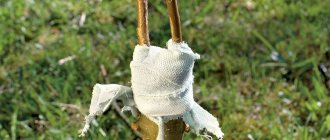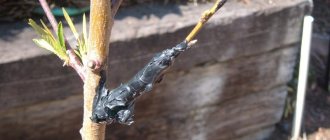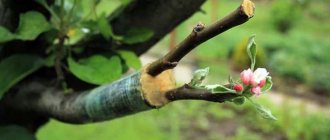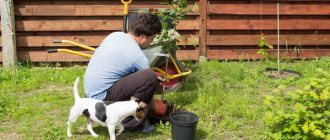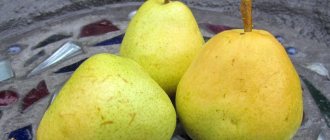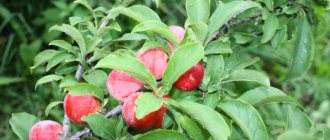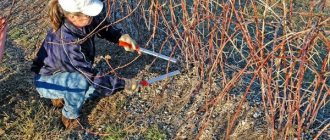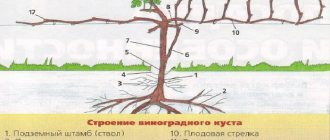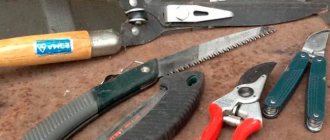Purpose of vaccination
The peculiarity of combining the plants themselves or their parts is the ability to obtain an optimal combination of the qualities of the strongest and most resistant to weather conditions and diseases of the plant with the high performance and quality characteristics of another crop.
It should be remembered that hybrid plants obtained as a result of grafting are not capable of forming fruits with similar quality indicators, and seed material will be produced exclusively on the upper part of such a plant.
Advantages and disadvantages of grafting cherries onto plums
- Grafting cherries onto plums has several advantages, in particular:
- improving the juiciness and taste of fruits after grafting;
- fruiting becomes better;
- crops exchange microelements, which enriches the fruit with nutrients;
- the wood's resistance to external influences increases.
Agronomists consider the disadvantage of this method to be not the highest survival rate. Combining cherries with other cherries or cherries is much more effective.
The concept of scion and rootstock
The plant from which the stem part and root system is preserved is usually called the rootstock, or base.
The part of the plant represented by the stem, leaves or fruits that is grafted onto the first plant, or rootstock, is the scion, or tip.
The highest level of grafting efficiency is observed when the parameters of the stem part of the rootstock and scion are the same.
For optimal results, you should choose one of the following types of rootstock:
- Forming rootstocks have lower indicators of resistance to climatic conditions and damage by bacterial microflora, but are characterized by high rates of formed yield.
- Vegetative rootstocks are more resistant to weather changes, but have some disadvantages in fruiting. They are optimal for use in long and warm seasons.
To determine the most optimal variety for use as a grafted plant, all qualities of the rootstock should be assessed.
Why graft cherries?
Tree grafting is an agrotechnical technique that allows you to propagate fruit trees. To perform the procedure, part of one tree is attached to another so that fusion occurs and the formation of one organism with improved characteristics.
Did you know? The oldest cherry tree in the world that bears fruit is a 150-year-old plant, reaching a height of 12 m and growing in the UK.
.
- The main advantages of cherry grafting are:
- preservation of varietal characteristics, which cannot be achieved by seed propagation of the plant;
- acceleration of the period of formation of the first fruits on a young tree - grafted cherries enter the fruiting period already 2-3 years after the manipulation, and plants that were grown from seeds begin to bear fruit only after 5-8 years;
- rejuvenation of the plant - a young cutting is grafted onto an old tree, restoring the productivity of the plant;
- increasing the plant’s resistance to common diseases of stone fruit trees and unfavorable environmental conditions;
- combining the qualities of several varieties to obtain a new sample with improved characteristics;
- saving space on the territory - instead of several varieties of cherries on one tree, you can graft and get a harvest of different fruits;
- the opportunity to save a tree broken during bad weather, whose roots were preserved in the soil.
The main disadvantage of cherry grafting is the weak strength at the site of plant growth. When choosing certain methods of manipulation, there is a risk of poor survival of the grafted cuttings.
Harvesting cherry cuttings in spring
The success of a procedure such as grafting directly depends on the density of contact of plant tissues on the rootstock and scion, which are represented by the vascular cambium. It is for this reason that the material used should be prepared competently and in a timely manner and make sure that the plant tissue is of high quality and suitable for grafting.
- Cuttings of any fruit plants should be carried out in the autumn, closer to winter, but before the onset of sharply negative temperatures.
- Cuttings harvested from apple and pear trees can be stored in moistened sawdust on the bottom shelf of the refrigerator.
- Cuttings taken from stone fruit plants are well preserved when frozen. Freezing should be carried out in frozen sawdust, having previously wrapped the cut cuttings in a damp rag.
Which rootstock is best to use for grafting?
The success of grafting largely depends on the rootstock - the plant onto which the scion is grafted. A high-quality rootstock has the following qualities:
- age 3–10 years;
- maximum height 3 m;
- low growth rate;
- absence of damage, rot, breaks;
- the variety is zoned in the growing region;
- The varietal characteristics indicate the rapid survival of scions.
With the right choice of rootstock, the grafted variety grows and after 5 years begins to bear fruit.
Vaccination methods
Currently, several grafting methods are actively used. Knowing the features and technique of each grafting method, the gardener can choose the most optimal and convenient option in each specific case. It should be remembered that it is advisable to carry out such activities in the morning or immediately after sunset.
Copulation
The method is quite easy, but requires strict adherence to the execution technology.
Choice of scion and rootstock
- The scion and rootstock cuttings must be dormant and have the same diameter, varying from seven millimeters to one centimeter.
- The standard length of the cutting should be about thirty centimeters.
- The cuttings must have at least three and no more than five buds.
Preparation of scion and rootstock
- Remove the terminal end on the scion.
- Make a bevel cut at the base of the scion.
- Make a similar bevel cut on the rootstock.
- Cut suitable “tongues” to secure the scion to the rootstock.
- Combine the scion with the rootstock and fix it using a special grafting tape or other elastic material.
After four weeks, the wrapping should be removed from the grafting site so as not to limit the growth of the wood. Below the grafting site, all growth should be removed regularly.
Budding
The most popular and widespread method of vaccination. Budding can be done even by a novice gardener.
Preparation of the rootstock
- Cut the area into a quarter of the rootstock at an angle without removing the bark.
- Cut a small section, aligning it with the corner cut until you have an indentation and remove the bark.
Scion preparation
- According to the size of the cut section of the rootstock, cut a scion cutting with a bud in the central part.
- Try the scion on the rootstock, adjusting the dimensions if necessary.
Direct grafting
- Place the scion in the recess on the rootstock, making sure that there are no gaps and that the fit is as tight as possible.
- Secure the scion to the rootstock with any elastic material.
The best option is to use polyethylene film. When fixing, you should not wrap the scion area with the bud with film. The retainer must be removed after four weeks.
If done successfully, the bud will begin to grow, and next year you will need to make an incision a centimeter above the awakened bud on the scion and remove any growth below the scion.
Into the cleft
This method of vaccination is recommended for use in the spring. A special feature is the ability to carry out work using mature plants and branches of another species (for example, a cherry plum branch is grafted onto a cherry tree).
Preparation of the rootstock
- Make a perpendicular cut on the lower branch, the length of which is at least fifteen centimeters.
- Make a central split of the rootstock to a depth of fifteen centimeters.
Scion preparation
- Cut off the end part and base of the scion cuttings.
- Make a bevel cut on the scion, the length of which corresponds to the depth of splitting of the rootstock.
Direct grafting
- Having widened the split on the rootstock, insert a beveled cut of the scion there.
- Seal all exposed wood after grafting with wax, garden varnish or emulsion.
Any growth that appears under the grafting site should be promptly removed. A scion that has not taken root or is too weak also needs to be removed.
On the bark
Cuttings are taken from healthy and productive plants, and the grafting itself must be carried out according to established technology. The method is relevant when there is a rootstock that is too large for standard copulation.
Choice of scion and rootstock
- A high-quality cutting has three branches at rest with at least three and no more than five buds.
- The length of the cutting should be about thirty centimeters.
- The rootstocks should be straight and smooth and have a diameter of five centimeters.
Preparation of scion and rootstock
- Trim a viable branch with healthy wood for the rootstock.
- Cut scions, the length of which should be about twelve centimeters, with five healthy buds.
- At a distance of seven centimeters from the end of the scion, make a beveled cut extending to the base.
Direct grafting
- In accordance with the size of the scion cuttings, make marks on the rootstock using a sharp knife.
- Cut off the bark of the rootstock according to the markings made with a knife.
- Place the scion cuttings on the indentations in the rootstock and, aligning them tightly, secure each scion with a pair of nails.
The cut site on the rootstock should be carefully treated using a special wax composition, garden varnish or emulsion. Any growth that forms under the grafting site must be removed.
Preparation of the rootstock
- Plum grafting should be carried out on healthy cherry seedlings that have been watered, weeded and fed in a timely manner. It is necessary to decide on which seedling the procedure will be carried out in advance in order to provide proper care in advance and prepare the plant for action.
- Felt cherry and common cherry plum are often used as rootstocks for plum grafting.
- It is recommended to carry out the procedure in the morning or after sunset, in calm weather, with air humidity of approximately 60%. On rainy and hot days, grafting cannot be done, otherwise the cutting will not take root.
- Having determined which plum rootstock will be used, all branches should be cut off in the selected area of the tree.
- The prepared area is thoroughly wiped with a clean cloth to prevent dirt and dust from getting into the cut. Contamination can lead to shoot rejection.
What can you graft cherry onto?
Initially, you should grow or select a high-quality rootstock, healthy, strong and young. The thickness of the stem part can vary from three to ten centimeters. It is allowed to use viable and maximally strong branches with a diameter of at least ten centimeters. In addition, plant compatibility should be taken into account.
Cherry
Grafting cherries onto cherries is the most optimal and common option. The most successful is to carry out spring vaccination. Both regular varieties of cherries and options combined with felt cherries can be used.
Cherries
This combination is often successful, due to the use of rootstock and scion from representatives of the same species. When grafting is carried out correctly at the optimal time, the cuttings take root quite quickly on the rootstock. Any variety of cherries can be used.
Currant
An interesting method of grafting currants onto a cherry rootstock has become widespread in Bulgaria. Here, cuttings are collected in early spring, followed by storing the material under the snow or in cellars. In the last ten days of March, grafting is carried out using the butt or split method.
Bird cherry
A very popular option. Bird cherry is widespread in the central zone of our country, it is a very unpretentious and winter-hardy plant, which allows you to obtain the highest quality, frost-resistant and viable rootstock.
Cherry plum
Gardeners quite often use cherry plum as a material for grafting , which is due to the presence of a very strong and hardy root system in this fruit tree, which has a fairly high level of frost resistance. Of course, it is also possible to carry out the reverse version of grafting: cherry plum to cherry.
Cherry on plum
Of the many stone fruits, plum is the strongest type of rootstock. The best option is to use semi-wild plums or sloe, which are characterized by easy adaptation to unfavorable climatic conditions and resistance to most diseases.
An interesting option is to graft felt cherries onto sloe or plum trees. As a result, it is possible to obtain a low-growing tree with a wide, spreading crown and a variety of flowers reminiscent of cherry blossoms.
We also recommend that you read the article about cherry hybrids.
Further care
In the first year after grafting, carry out preventive treatment of the tree against pests. Experienced gardeners advise using Biotlin or Tanrek products. Branches growing near the grafting site should be removed - such stems take up plant juices and prevent the cutting from taking root. If the procedure was carried out in the spring, at the end of summer the tops should be pinched.
Important! Do not forget about the standard varietal norms for caring for plums. With proper watering and fertilizing, cherry grafting shows better survival rate.
Cherries will successfully take root on a plum tree if you follow the deadlines and choose the appropriate method for carrying out the procedure. Taking into account all these subtleties, the gardener will successfully cope with the task and after a while will receive a rich harvest of cherries.
Tips and tricks
If the winter is too warm, it is possible to harvest cherry shoots for grafting. The cuttings are cut in mid-March and stored wrapped in a damp rag on the bottom shelf of the refrigerator. The technique for grafting any stone fruit plants involves using an exceptionally clean and sharp budding or copulating knife.
All actions during vaccination should be performed as quickly as possible. For fixation, it is recommended to use a special grafting tape, which can be replaced with polyvinyl chloride or polyethylene film.
How to plant a plum tree correctly, timing and features
Properly cared for fruit-bearing plum trees always delight the gardener. Starting from early spring and ending in late autumn, he nurtures them, looks after them, fertilizes them, and removes excess growth. He tries to do everything so that the garden has the opportunity to fully develop and bring joy to its guardian in the form of a rich harvest. This is correct, this is how a real owner should have it. But even with the most ideal care, at certain periods of development the plum tree must be grafted. To say that this procedure is mandatory is not true, the tree has grown and will continue to grow. But what will it be and with what harvest? In the first years of its development, it will, of course, be “correct”, that is, it will grow normally and bear good fruit. Next, who knows.
Why is vaccination needed?
On a global scale, plum grafting in the spring is an additional activity. Tree trimming, processing and everything else is a must.
Vaccination is done optionally in order to:
- rejuvenate an old tree. When the trunk is still in good condition, young shoots will eventually replace the old branches;
- get a variety with other qualities. Be that as it may, if the rootstock (this is where they are grafted) and the scion (what is grafted) are different, the first will always transfer some qualities to the second;
— grow different subspecies of plums on one tree. On the one hand, this is interesting. On the other hand, it is convenient when there are different fruits on one tree. Thirdly, why not experiment and have, say, cherries and plums in one “person” in your garden;
- increase productivity and ease of use of plantings. As an option, grafting a plum onto a felt cherry. The trees turn out to be relatively short, they begin to bear fruit earlier, plus the yield is higher.
But again, all these recommendations are only for those who have a desire to make the garden more interesting and better.
Plum grafting: optimal timing
We don't discuss winter. Spring, summer, autumn - these are the periods suitable for working in the garden with grafting material. This is, if in principle. In fact, plum grafting in spring is preferable. In the spring, increased movement of sap begins, the trees begin to grow, and the scions take root well. In the fall, it is not prohibited to improve plum plantings. Everything will be fine, provided that the cuttings have enough time to take root on the rootstock before winter. Summer is neither good nor bad. There is enough time before frost, however, a tree formed in spring does not quite like summer procedures. It turns out, based on the characteristics of each period, the best time for vaccination is spring.
What type of vaccination should I choose?
Grafting a plum and grafting an apple tree, or any other fruit tree, are no different. The same tools, the same general rules for vaccinations. So to make it clear what we are talking about, let’s briefly consider the main types.
1. Copulation – carried out when the thickness of the rootstock and scion is the same.
2. Improved copulation - the principle is the same, only an additional cut is made on the handle for better contact of the cambium (core of the tree).
3. Budding - a type of grafting with one cut bud. Unlike all other types, it can be performed with equal success in both spring and summer.
4. In a split - when a thin scion is split in the center onto a cut full-fledged branch or trunk.
5. There is almost a split under the bark, the cutting is fixed to the side of the rootstock.
6. In a corner cut - requires a certain skill and experience from the gardener.
In terms of survival rate, if everything is done as it should, budding and everything else are the same. The choice of type of vaccination depends on what you ultimately need to get. For example, the first three types allow you to improve and diversify the plum. The rest are more suitable for rejuvenation.
How to prepare cuttings?
A crucial moment in the life of any gardener before planting a plum tree in the spring in any form. At first it seems that working with cuttings consists only of attaching them to the rootstock. Everything is a little different. To achieve a positive result the first time, the cutting must be cut correctly, stored correctly and used on time. To simplify the situation, if someone knows an apple tree but not a plum tree, the preparation and preservation of cuttings is carried out according to the same rules.
The main stages of work with grafting material are as follows:
— timely pruning of young shoots;
— ensuring optimal storage conditions;
— proper spring preparation of cuttings;
— timely holding of spring events.
The only exception in vaccinations is budding. The bud is never harvested for future use; it is cut off from the shoot and immediately identified as a rootstock.
Of course, no job is without its nuances. If the grafting is carried out using a cutting, you don’t have to prepare it, but combine business with pleasure. Cut the cuttings not for the winter, but in the spring during the planned clearing of excess growth from trees. Scions are obtained in such a quantity when they are not selected, but sorted out.
Rootstock. Nuances of choice
You can graft a plum tree onto anything, but then depending on your luck. If the tree species are compatible in their characteristics, the cutting will develop; if not, then it’s not fate. Only this approach to business is more common among novice gardeners. Any grafting of a fruit tree is carried out either on the same or similar. Plum is no exception. Grafting plum onto plum is an ideal option in every way. But sometimes there are not enough “free” plum trees in the garden. It’s okay if cherry plum grows on the site. The solution to the situation is not ideal, but almost close to it.
Apricots also take plum grafts well. The only thing is to avoid falling on a spoiled apricot rootstock, you need to carefully choose the grafting site.
“Crossing” a plum cutting and a felt cherry rootstock works well. The tree grows short, easy to “use”, and begins to bear fruit earlier. Felt cherries can easily be replaced by wild cherries. The only drawback of weak-growing rootstocks is that the fruits on them grow somewhat smaller. But due to the growing conditions, for example, problematic soil, such “hybrids” are very picky. They grow where an ordinary plum doesn’t particularly like to grow.
One last thing to note. Before grafting cuttings or buds onto a plum tree in the spring, it is advisable to take not the first ones that come along, but well-developed ones, without obvious diseases. The grafting material will be of high quality, the procedure was carried out correctly, and any difficulties during the survival period are unlikely to arise. Whether or not to care about a plum orchard in terms of grafting is up to each gardener to decide for himself.
